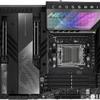Introduction
ASUS ROG Crosshair Z670E HERO review
ASUS has released one of its finest Z670E AMD AM5 motherboards, loaded with features meet the ASUS ROG Crosshair Z670E HERO. The Z670E board is equipped with an LGA 1718 socket and can support the entire line of Ryzern 7000 Desktop CPUs. The more affordable motherboards for AMD's Ryzen 7000 processors will be available on the B650 and B650E platforms. The X670/X670E platforms will be more costly overall but will offer OPCUe Gen 5.0 PCIe Express lanes for graphics and more USB and SATA options as well.
DDR5 memory and PCI Express 5.0 connectivity are among the new features. There is a clear distinction between the X670 and X670E, with the latter guaranteeing PCIe 5.0 for both graphics card slots and the NVMe slot. The actual method of differentiating B650 and B650E from the X670 is not that hard; X670 and X670E consist of two physical chips, while those of the B650 family consist of only one. As a result, onboard I/O on B650-class motherboards will be cut in half. The motherboard features a dual 8-pin connector for powering the CPU socket and is powered by a 20 virtual phases (18+2), 10 real phases (9+1), and PWM-Controller: ASP2205 (max. 12 phases). For the ones interested we spotted MOSFETs CPU to be 18x 110A SiC850A and MOSFETs SoC2x 110A SiC850A.
The motherboard features dark heatsinks above the power supply, providing adequate cooling for the electrical components beneath. Regarding procedure memory, the board features four DDR5 DIMM slots that support EXPO overclocking. ASUS equips the board with 2x PCIe 5.0 x16 (1x x16, 1x x8), 1x PCIe 4.0 x1, 2x M.2/M-Key (PCIe 5.0 x4, 2280/2260/2242), 2x M.2/M-Key (PCIe 4.0 x4, 2280/2260/2242). The PCH heatsink is coated in a dark palette and embossed with the product features. Additionally, the board features six SATA III ports. The rear panel connectors include a wide variety of USB 3.2 Gen 2 slots including 20 Gbps, HDMI, Display-Port, a 2.5G Ethernet port-based, and a seven-channel audio jack array. We'll load this motherboard up with a Ryzen 7 7700X processor and see how well she handles it. Let's have a peek.
AMD Ryzen 7000 (codename Raphael) Desktop CPU Specs | |||||
|---|---|---|---|---|---|
| Cores / Threads | Base/Boost Clock | TDP | Cache (L2+L3) | Launch Price(USD) | |
|
AMD Ryzen 7000 Zen4 (Raphael) | |||||
| Ryzen 9 7950X | 16C/32T | 4.5/5.7 GHz | 170W | 80MB (16+64) | 699 USD |
| Ryzen 9 7900X | 12C/24T | 4.7/5.6 GHz | 170W | 76MB (12+64) | 549 USD |
| Ryzen 7 7800X | - | - | - | - | 449 USD |
| Ryzen 7 7700X | 8C/16T | 4.5/5.4 GHz | 105W | 40MB (8+32) | 399 USD |
| Ryzen 5 7600X | 6C/12T | 4.7/5.3 GHz | 105W | 38MB (6+32) | 299 USD |
| AMD Ryzen 5000 Zen3 (Vermeer) | |||||
| Ryzen 9 5950X | 16C/32T | 3.4/4.9 GHz | 105W | 72MB (8+64) | 799 USD |
| Ryzen 9 5900X | 12C/24T | 3.7/4.8 GHz | 105W | 70MB (4+64) | 549 USD |
| Ryzen 7 5800X3D | 8C/16T | 3.4/4.5 GHz | 105W | 100MB (4+96) | 449 USD |
| Ryzen 7 5800X | 8C/16T | 3.8/4.7 GHz | 105W | 36MB (4+32) | 449 USD |
| Ryzen 7 5700X | 8C/16T | 3.4/4.6 GHz | 65W | 36MB (4+32) | 299 USD |
| Ryzen 5 5600X | 6C/12T | 3.7/4.6 GHz | 65W | 35MB (3+32) | 299 USD |
A first in a long time is a new processor socket, which allows for features like DDR5 and PCIe 5.0, and necessitates the purchase of new motherboards. The 600-series chipsets are built into these (X670E, X670, B650E, and B650). All the processors include an integrated RDNA2 GPU and PCIe 5.0 and DDR5 compatibility (E suffix is Extreme). In this review, we'll look at the Ryzen 7 7700X in combination with the ASUS ROG Crosshair X670E Hero motherboard.

